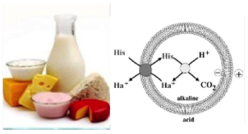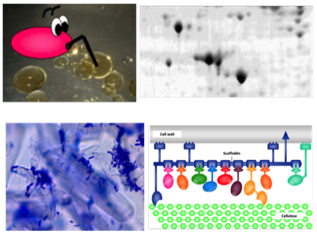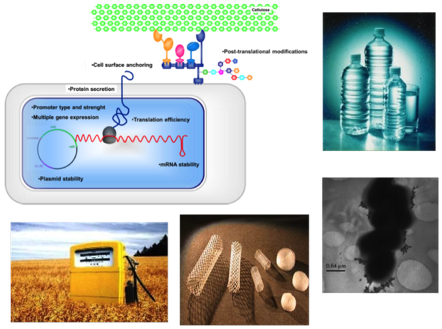







• Aromatic pollutant bioremediation. Acinetobacter radioresistens S13 was isolated in our laboratory because of its ability to degrade aromatic hydrocarbons (e.g. phenol, benzoate). Its aromatic compound catabolic pathways are currently being studied at both global (proteome) and single enzyme levels.
• Plant biomass degrading microorganisms. The cellulase system and the metabolism of natural cellulolytic bacteria (e.g. Clostridium cellulovorans) grown on different plant biomass is currently being studied by both physiological and proteomic viewpoints.
• Food fermentation and nutraceuticals. Research focus is mainly on lactic acid bacteria involved in food fermentation (wine, dairy products) and either producing biogenic amines (e.g. histamine, tyramine, GABA) or able to accumulate essential elements for human health (e.g. Selenium). Biogenic amines obtained by aminoacid decarboxylation can be found in fermented food and have generally negative effects on either food quality and/or safety. An exception is GABA that has hypotensive and nutraceutical properties.
Metabolism biochemistry of microorganisms of applicative interest
Fermentation, enzymology, proteomics and metabolite analysis are the main approaches that we are currently using for in depth-understanding of the metabolism of microorganisms of applicative interest:
Proteomics and metabolic engineering of prokaryotes (PMEP)
Development of consolidated bioprocessings for waste biomass conversion into high-value products
Economic viability of biorefinery strategies, producing high added-value molecules by microbial fermentation, relies on the utilization of cheap substrates and processes. Waste lignocellulosic biomass is among the most attractive raw materials because of its high abundance, low price and reneawability. However, current waste biomass bioconversions are economically inefficient multistep processes. Our research projects aim to develop consolidated processings for one-step fermentation conversion of waste biomass (agro-industrial waste, municipal solid waste, industrial waste) into biofuels and bioplastics. Experimental strategies that are employed include both metabolic engineering of microbial strain by genetic techniques (rational engineering and in vivo evolution) and fermentation process optimization.
• Construction of recombinant cellulolytic bacteria by metabolic engineering. Recombinant cellulolytic microorganisms able to perform single-step fermentation into products (consolidated bioprocessing; CBP) by either the heterologous expression of minimal cellulase systems in microorganisms with product features or by conferring to natural cellulolytic microorganisms the ability to produce high added value molecules are currently being developed in our laboratories. Among them, main efforts are focused on the construction of a cellulolytic lactic acid bacterium for the production of optically pure lactic acid for polylactide (a biodegradable and biocompatible plastic) synthesis.
• Development of consolidated bioprocessing for waste biomasses. A fermentation strategy consisting in the co-cultivation of natural cellulolytic microorganisms (e.g. Clostridium cellulovorans) and solvent producing microorganisms (e.g. Clostridium acetobutylicum) is currently developed for the conversion of lignocellulosic biomasses into biofuels (ethanol, butanol and hydrogen). Furthermore, genetic and fermentation approaches are currently used to develop fermentation processes converting waste vegetable fatty acids into building blocks for plastic polymer manufacturing.
• Construction of nutraceutical overproducing microorganisms by metabolic engineering. Genetic manipulation and fermentation techniques are used to engineering the metabolic pathways of microbial strains (e.g. Lactococcus lactis) so to overproduce molecules of food and nutraceutical interest (e.g. GABA, Se-metabolites)


